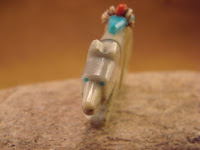Uh oh. I think this is the start of something. Whilst in Minnesota I came across a fetish.... Not the crazy foot kind or anything unsavory like that, but the Native American kind. Zuni Fetishes were traditionally made by the Zuni Indians. The carvings served a ceremonial purpose for their creators and depicted animals and icons that were important in their culture. Today they are recognised as contemporary Native American art worldwide. Traditionally the materials used by the carvers were often indigenous to the region. The most important material was turquoise, which is considered by the Zuni as the sacred stone. Jet, shell (mother of pearl), coral, fish rock, jasper, pipestone, marble and organic items like fossilized ivory, bone and deer or elk antler were also frequently used. Historically the most used stone was serpentine, a local stone found abundantly in the Zuni Mountains and in Arizona.
In tradition, each animal is believed to have powers or qualities that may aid the owner. The Navajo, for example, treasured and bartered for figures of horses, sheep, cattle or goats to protect their herd from disease and to ensure fertility (Cushing, 1994, Bahti's Introduction). The Zuni hunter, or "Prey brother", was required to have his fetishes (prey gods of the hunt) with a "Keeper" and practice a ceremony of worship when procuring a favorite or proper fetish to aid in a successful hunt. In the ceremony of the hunt the Keeper presented a clay pot containing the fetishes to the hunter. Facing in the direction appropriate to the chosen fetish the pot was sprinkled with medicine meal and a prayer was recited. The fetish was placed in a buckskin bag and carried by the hunter over his heart (Cushing, 1994:33). Each artist's styles are as unique as the artists themselves, and there are many whose works are highly sought after by collectors. Some collectors prefer a figure that is more realistic in appearance, while others prefer the more traditional styles that are intrinsic to Zuni belief.
The traditional belief of the Zuni is that the least modification of the original material maintains, or heightens, the power of the fetish as a "natural concretion" (Cushing, 1994:12). A fetish may be signed by the carver, or not. Personalization by signing a piece of art traditionally violates the Zuni notion of community purpose, and the signing of artwork is a concept introduced to the Zuni by Anglo collectors at the beginning of the twentieth century (c. 1915). Often, though, a Zuni carver feels that their own unique style is readily identifiable and the fetish's style will be enough to identify the carver as surely as would any other mark. Most carvers are the recipients of a family tradition and have learned their skill from parents, grand parents, or siblings, and have passed the art to their own children as well.
Besides being made from various stones and other materials (each material has unique properties), the contemporary fetish may carry an offering of a smaller animal or a prayer bundle of carved arrowheads with small beads of heishe. It may be adorned with a heishe necklace, feathers, etchings representing ancient petroglyphs, or an etched or inlaid heartline. These small items, although colorful to the eye, are intended to protect and feed the fetish itself (Cushing, 1994).
Oh Ebay... So the little Zuni bear above is making it's way to England as we speak. He is approximately 1 1/16" in length and 1 1/2" in height. It is carved from serpentine, with an abalone arrowhead overlaid with turquoise block and attached with sinew. The eyes are inlaid with turquoise. The carver was Wilford Cachini.
I have a beady eye on you guys below...



kE9s4,BEQ8BQL0O41IpQ~~60_1.jpeg)
hWBQL0O0Vor!~~60_1.jpeg)








No comments:
Post a Comment